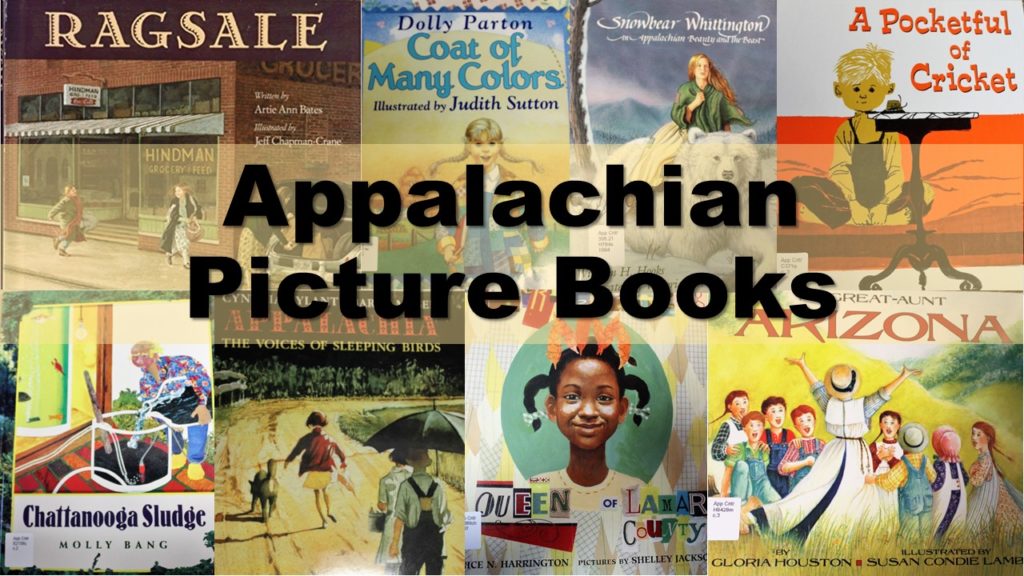“Librarians recognize that a young child’s response to a story is dependent on the degree to which that story is rooted in that child’s experience. Teachers know that children learn to read with far greater ease if their reading material deals with familiar surroundings and customs.” – Judy Martin

When I first began working at the Loyal Jones Appalachian Center I was immediately drawn to Faber Library and its vast collection of Appalachian literature. As a picture book enthusiast I began to explore the shelves for picture books, but found only 6. I took it upon myself expand the Faber Library picture book selection which led to a journey full sociological questions of surprising discoveries. I learned that while there are many picture books out there representing Appalachia, the majority seem to revert to the typical, rural stereotypes and fail to represent the rich variety of Appalachian experiences in this diverse region. I conducted a study on 48 Appalachian picture books looking for 4 different things: Who are the protagonists? Are there trends for stereotypes? Where are the authors from? Where are the illustrators from? Here is what I discovered.
- The majority of Appalachian picture books appear to be set in a time period before indoor plumbing. As I studied each picture book I looked to see if the homes/settings appeared to have indoor plumbing and electricity and this is what I discovered. 18 picture books portrayed houses with no indoor plumbing. That is 39%! I counted only 6 picture books that definitely depicted houses with indoor plumbing with clues such sinks or hoses, and the rest of the books were either ambiguous or represented houses both with and without indoor plumbing. There indeed seems to be a trend insinuating that people tend to represent Appalachia in past tense with a sense of nostalgia, rather than providing contemporary examples.

- The two most common Appalachian stereotypes I came across in these books were: barefooted protagonists and isolated log cabins.

- Out of the 42 in my study featuring protagonists 15 of them were barefooted. That is a significant portion of 36%.
- Nearly a quarter of the picture books, 10 of the 48, featured isolated log cabins as one of the main settings.
- While there is some diversity among this sample there needs to be more. The only ethnicities represented were white (88%) and black (12%). Appalachia is so much more diverse than this and that needs to be represented!
- Most of the protagonists are female, which I found surprising because in most genres male protagonists are in the majority. 27 out of 42 picture books (64%) featured a female protagonist, while only 13 featured male protagonists (31%). 2 books featured both male and female protagonists. My hypothesis is that this is because the vast majority of the picture book authors are female (88%). Only 6 out of the 48 picture books in my study were written by male authors.

- While most picture books in my study were written by Appalachian authors, a surprisingly low percentage of illustrators, 23%, came from Appalachia. Only 11 out of 48 picture books had Appalachian illustrators in contrast with 40 out 8 picture books with Appalachian authors. This is concerning because illustrators play a significant role in telling the story and if they do not have a personal history or in-depth understanding of Appalachia they are more likely to misrepresent it.

Through my research I found example after example of non-Appalachian illustrators reinforcing stereotypes, and I’m not the only one who has noticed this. Karen Roggencamp, conducted an excellent study of 3 books written by Cynthia Rylant, analyzing the illustrations from each book. She found, “A tension emerges between word and image, for the illustrations by Diane Goode and Stephen Gammell present external images that draw upon long-standing and problematic caricatures of Appalachia. The result is that while Rylant’s prose directs attention away from stereotype, the illustrations serve to reinforce stereotype.” To read the full article please visit https://muse.jhu.edu/article/239641
Since picture books can play such a huge role in a how a child develops a sense of identity it is so important to avoid negative stereotypes, and represent Appalachia as accurately as possible. As George Ella Lyons, a distinguished Appalachian picture book author, said “If we do find characters who are supposed to be us in books and their depiction is demeaning and embarrassing, this reading only alienates us from ourselves. We are not those people, so if they are Appalachian we must not be. With this perception we are displaced, disinherited. Just like that.”
Article Written by Heather Dent